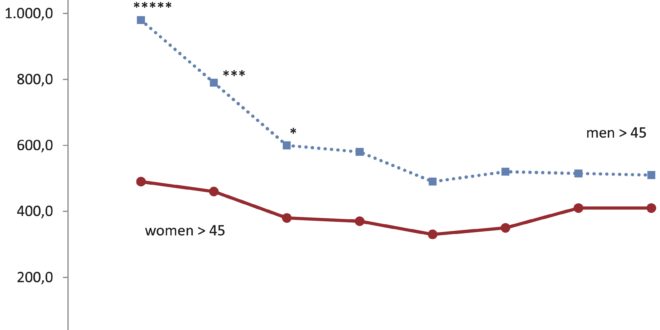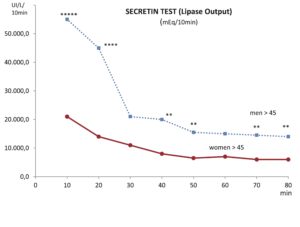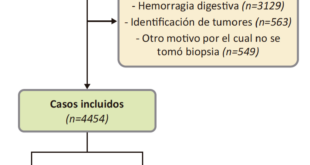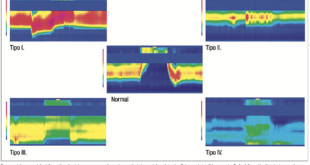Osvaldo Manuel Tiscornia,1 Fabiana Norma López Mingorance,1, 2 Julieta Agustina Repetti,1 Simmy Bank,3 Patricia Graciela Tiscornia-Wasserman1-4
1Programa de Estudios Pancreáticos, Hospital de Clínicas “José de San Martín”, Universidad de Buenos Aires.
2Departamento de Bioquímica Clínica, Hospital de Clínicas, FFyB, INFIBIOC, Universidad de Buenos Aires.
Ciudad Autónoma de Buenos Aires, Argentina.
3Dept. of Gastroenterology of Long Island Medical Hospital. EE.UU.
4Dept of Cytopathology, Columbia University. EE.UU.
Acta Gastroenterol Latinoam 2019;49(4):324-330
Recibido: 03/04/2018 / Aprobado: 28/06/2019 / Publicado en www.actagastro.org el 17/12/2019
Summary
This study pivots on exocrine pancreatic secretion. We choose 45 years limit, distinguishing two stages characterized by an imbalance of sexual hormones in women and men. The secretin test was performed on 40 women and 47 men to evaluate the exocrine pancreatic function, taking age, as the central axis. In the group analyzed below the age of 45 there were no significant differences in the agreement with sex; but there were relevant differences between men and women above 45 years of age. The hormone secretin regulates the synthesis of lipase by interacting with the intrapancreatic cholinergic tone. When this is depresses, so does the debit of lipase. Pancreatic acini and islets have a high number of estrogen receptors, which activate and modulate the response of the gland to secretin, CCK and acetylcholine. Estrogen activates the beta cells stimulating the release of insulin, which enhances the ecbolic secretion induced by CCK. We conclude that during menopause the decrease in estradiol leads to less interaction with the secretin hormone receptors, which leads to a high percentage of dyspeptic syndrome, ultimately menopausal chronic pancreatopathy / menopausal pancreatic insufficiency. This is reversed with the administration of estradiol. In men older than 45 years we observed an increase in lipase secretion, a consequence of a hyperestrogenism caused by the aromatization of androgens. From clinical experience we observed the beneficial effect of citrate powder in patients with dyspeptic syndrome, gastritis and pancreatopathies, which demonstrate that they induce the release of secretin from the duodenal mucosa.
Key words. Secretin, plexus reticular, citrates, menopause.
Función del páncreas exocrino – sexo, edad, tono colinérgico y estrogénico – valor clínico preliminar de los citratos
Resumen
Este estudio pivotea en la secreción pancreática exocrina. Tomamos como eje los 45 años, distinguiendo dos estadíos caracterizados por un desbalance de hormonas sexuales en mujeres y hombres. Se realizó el test de secretina a 40 mujeres y 47 hombres para evaluar la función pancreática exocrina, tomando como eje central, la edad. En el grupo analizado por debajo de los 45 años no demostró diferencias significativas de acuerdo al sexo; sí resultó ser relevante la diferencia entre hombres y mujeres por encima de 45 años. La hormona secretina regula la síntesis de lipasa interactuando con el tono colinérgico intrapancreático. Cuando este se deprime, también lo hace el débito de lipasa. Los acinos e islotes pancreáticos contienen un alto número de receptores estrogénicos, que se activan y modulan la respuesta de la glándula a la secretina, la CCK y la acetilcolina. El estrógeno activa las células beta estimulando la liberación de insulina, que potencia la secreción ecbólica inducida por la CCK. Concluimos que durante la menopausia la disminución del estradiol conduce a una menor interacción con los receptores de la hormona secretina, lo que deriva en un alto porcentaje de síndrome dispéptico, en última instancia, la pancreatitis crónica menopáusica/ insuficiencia pancreática menopáusica. Ello se revierte con la administración de estradiol. En el hombre mayor de 45 años observamos un incremento de la secreción de la lipasa, consecuencia de un hiperestrogenismo ocasionado por la aromatización de andrógenos. Desde la experiencia clínica observamos el efecto benéfico de los polvos de citrato en pacientes con síndrome dispéptico, gastritis y pancreatopatías, lo que demuestra que inducen la liberación de secretina desde la mucosa duodenal.
Palabras claves. Secretina, plexo reticular, citrato, menopausia.
Abbreviations
CEPS: Exocrine Pancreatic secretion.
NPF: Neural Plexual Freeway.
PVR: Peri-Vaterian region.
CB: Cicatricial barrier.
ICR: Ileum-cecal region.
AIW: Ascending-inhibitory wave.
This study pivots on human exocrine pancreatic secretion (EPS). We choose 45 years limit to distinguish two different stages of life, focusing on the sexual hormones that fall during menopause leading to loss normal estradiol potentiation of the cell membrane secretin receptors, which results in the development of a high percentage of dyspeptic syndrome and ultimately menopause chronic pancreatitis.
Secretin regulates the synthesis of lipase interacting with the intrapancreatic cholinergic tone. When this tone falls also does lipase output. The pancreas’s cells contain a high number of estrogen receptors, which activate and modulate the gland’s response to secretin, CCK and acetylcholine. Menopausal women are typically characterized by a depress of EPS, which reverts after estradiol administration. Estrogen activates beta cells, stimulating insulin liberation, which potentiates the pancreon’s CCK ecbolic secretion. The hyperestrogenism in men above 45 years old enhances lipase secretion.
Dr. Polak’s citrates powder induces secretin release from the duodenal mucosa and we used them to treat clinical cases of gastritis syndrome, dyspepsia and pancreatopathies.
Material and methods
The study was performanced in patiens according to the guidelines of the World Medical Association Declaration of Helsinki. The analysis was carried out with the classical Dreiling test.1-3 Starting in the sixties, at the Mount Sinai Hospital (N.Y), afterward at the Sarles Lab. (Marsella) and Clinicas Hospital (Buenos Aires), we were able to analyze the exocrine pancreatic secretion (EPS). The evaluation was done in 40 women and 47 men, stratified into three groups of subjects:
Two groups above 45 years, the first there were 20 tests in males, median age 55 years (range: 47-81) and the second, there were 18 tests in females, median age: 52 years (range: 45-62). The third serie under 45 years there were 26 tests in males, median age: 35 years (range: 21-44) and 20 in females, median age: 37 years (range: 24-43).4, 5
After duodenal intubation with a double lumen tube, gastric and duodenal juices were collected separately. Boots secretin was injected as a bolus at the standard dose of 1,0 U/kg. The duodenal aspirate was collected by intermittent suction over the next 80 minutes, divided into 10 minutes periods. The 80 minutes cumulative values were also analyzed. The hydrelatic and ecbolic responses were measured by the following parameters: volume (ml/10 min), HCO3-meq/l, according to the titrimtric method with nitric acid (Lehmann),6 lipase concentration was determined by Lehmann´s7 method and amylase concentration, in the secretory pool by the Jungen method.8
Results
Men and women above 45 years of age: The post-secretin collection data showed that in the women group values were consistently lower than those for men. Lipase activity (Figure 1) and output (Figure 2) showed statistically significant differences. In the cumulative 80 minutes values, in men and women, all measures were consistently lower for women than for men. Bicarbonate output and volume values revealed statistically significant differences (Figure 3 and Figure 4).
Figure 1. Post-secretin secretory patterns of men vs. women over the age of 45, Lipase activity.
Figure 2. Post-secretin secretory patterns of men vs. women over the age of 45, Lipase output.
Figure 3. Post-secretin secretory patterns of men vs. women over the age of 45, Lipase activity.
Figure 4. Post-secretin secretory patterns of men vs. women over the age of 45, Lipase output.
Men and women under 45 years of age: Analysis of the values of all parameters, in each of the eight 10 min periods, showed that there were not significant differences in the parameters flow, bicarbonate concentration and output of the duodenal juice collected after secretin intravenous stimulation.
Discussion
The present findings confirm our previous observations1-5 that in humans, the response of the exocrine pancreas to hormonal stimulation does show differences between sex- and age-linked differences; these, in the pancreatic secretion were most notorious above 45 years. Fluid secretion tended to be greater in men than in women and it was significantly decrease in women overhead than 45 years.
The ecbolic function of the pancreas showed age and sex-dependent values for certain enzymes, especially lipase secretion was affected, but amylase was not.
The present results disclose that men above 45 years. have a greater post-secretin EPS than women; these are consistent with previous observations.
In Dreiling Lab, working with Hansky,9 we attempted to compare results between dogs and humans. Using 12 randomly selected normal subjects, six males and six females, we analyzed the response to a standard secretin test and found the mean peak 15-minute bicarbonate output to be 6.9 mEq in women and 8.8 mEq in men. The calculated bicarbonate output per gr of the human pancreas was 0.088 mEq/gr in females and 0.09 mEq/gr in males. This finding was consistent with the observation that a female dog excreted the same amount of bicarbonate (0.08 mEq/gr) as the human female did. Further analysis of the data indicated that bicarbonate output in men, per gram of gland, increases with age; in women were the inverse relationship develops.
In order to understand the behavior of pancreatic lipase, several findings should be taken into consideration. A crucial report was that of Rausch et al.,10 in the sense that secretin is the hormone who stimulates enzymes synthesize. This interaction takes place with the intrapancreatic cholinergic tone. When this fall, lipase output decline, the reverse is also true. Another feature to take into account is estrogen receptors are found in much higher number in the pancreas than other organs. Their activation modulates the response of the pancreas to secretin and CCK. Our findings with secretin in menopausal women, characterized by a depressed EPS, are reversed when estradiol is given to patients.11-13
In order to get a better understanding of the pancreatic secretory changes linked to sex and age, is necessary to consider several physiologic findings, some of them well studied in the experimental animal. Concerning the lipase secretion, the secretin hormone plays a pivotal role. As it was already mentioned, this hormone is the main agent of synthesis and secretion stimulation in the pancreatic juice. Besides, the effects of the hormone are exerted interacting with the intra-pancreatic cholinergic tone and the one provided by the estradiol hormone. We have suggested an interplay develops between the secretin cells membrane receptors with those of the estrogen in the cytosol. In this type of assessment, performed in rats, we have pointed out that, the female hormone activated the beta cells of the Langerhans islets. The insulin hormone potentiated the “pancreon’s” ecbolic secretion.
A feature to emphasize is the significative enhance lipase secretion in men above 45 years. in contrast to the absence of this difference in persons below this time limit. In respect to this finding, our postulation is that the physiologic mechanism is centered in the relative hyperestrogenism that develops in the men group with advancing age; that involves the following events sequence: a) the fall of testosterone secretion by the testis; b) the aromatization process of the androgenic agents; c) the potentiation of the whole sequence by alcohol feeding. The latter well explained by the fact that, chronic alcoholism induces a notorious enhancing of the number of estrogenic receptors, both in the liver and pancreas. This observation of our group was well taken by Gumaste as a suggestive index to point out the etiologic agent of an episode of acute pancreatitis.14, 15 This gets confirmation when an episode of acute pancreatitis reveals, in blood, a preferential rise of lipase vs amylase. This observation gives solid support to an alcoholic etiology.
Other observations, linking interrelations between estradiol, the synthesis and secretion of lipase, were referred by Hilgendorf et al.16 and Blevnis17. They showed that estradiol, impinging upon isolated acinar cells, induce enzyme secretion. This finding is associated with the histologic image of zymogen granules “trapped” in the acinar cytosol. This is in total contrast with those that are appreciated with the hormone CCK. In respect to the above findings, we consider that a feature deserving to be mentioned is the one we have observed in dogs subjected to supramaximal dosis of intravenous secretin. In these tests was surprising and notorious the picture of zymogen granules “trapped” against the apical membrane of the “pancreon” acinar cells.18 We got these findings in the Sarles Lab given further basis to the notion that the secretin hormone is the main agent that synthetize the lipase enzyme.
In the seventies, following Polak personal communication we designed a pharmaceutical prescription formula with a mixture of citrates, under advice of a pharmacologist.19 Those citrates, releasing secretin from the duodenum jejunal mucosa, elicit a series of positive changes upon the whole gastrointestinal tract. The main mechanism involved is the induction of a protective layer of mucus. At the level of the stomach and duodenum plays the substantial role of enhancing the protective mechanism against the injurious influences exerted by an excessive chloride acid secretion. We administrated this preparation during meals to patients with clinical cases of gastritis, syndrome dyspeptic and pancreatopathies. Another interestingly fact of benefit citrates effects is prevented the duodeno-gastric and gastro-esophageal reflux elicited by the citrate-induced secretin. In addition to all the above facts, it deserves to be taken into account the excito-secretory role of the released secretin upon both; the hepatobiliary and exocrine pancreatic gland, conjunction with a cholinergic tone, those two secretions are essential to get an efficacious digestive process and a modulatory role upon both; the motility and chloride acid secretion of the stomach.
Another way, in this decade, we described, for the first time in the literature, by means of a macroscopic anatomic dissection that both; in human cadavers and in dogs and rats a duodeno-pancreatic-cleft- plexus (DPCP) is found. Subsequently, we were able to develop a conceptual synthesis of the neural plexual freeway (NPF).20, 21 Its distinctive quality is that of being functional even when disconnected from cephalic and spinal tract afferences following celiac ganglionectomy plus bilateral vagotomy. Its remarkable feature is that of its ganglion plexual reticular arrangement all along the gastro-intestinal tract; the latter similar to the one observed in the reticular tract, in the central nervous system (CNS).
The above facts justify assimilating the peculiarities of the entero-pancreatic innervation to those of a real “freeway”, this mainly in the sense that the flow of neural impulses take place following precise “lanes” in search of different final objectives. Undoubtedly, a key region of what we have described as an NPF is the peri-Vaterian-region (PVR).22-25 Here many visceral neural fibers jump the duodeno-pancreatic-cleft to enter into the pancreatic gland. They are cholinergic and serotoninergic exerting a modulatory influence upon the intra-pancreatic ganglia. A feature to emphasize is the presence of cholinergic “command neurons”. In fact, it deserves to be considered a real parasympathetic nucleus. It derives from the “ventral primordio” of the pancreatic gland, source of the inferior segment of the head and of the “processus uncinatus”. Subsequently, was known as the “hook”, rich in Langerhans islets, with predominant PP cells.
Interfering the course of the NPF with “cicatricial barriers” (CB), induced by section and re-anastomosis of the intestinal wall, performed at certain elective zones, allowed to get valuable information of diverse characteristics. Thus, in the stomach, at the level of the antral fundus intersection”, CB induced a peptic ulcer in the antrum. This surgical model of peptic ulcer evolved, in a good percentage of the cases, to an adenocarcinoma. The above findings led us to consider the «antral-fundus-junction» as the 1rst modulatory center of the NPF.
When performing secretory studies in dogs, provided with several Thomas cannula: in the stomach, to divert gastric juice, in the duodenum to collect bile-pancreatic juice, in the ileum and cecum, to instillation oleic acid, with which we put in evidence a remarkable inhibitory phenome of bile-pancreatic secretion, we were able to delineate the 3rd modulatory center of the NPF, with epicenter in the ileum-cecal region (ICR).
In what concern to the peri-Vaterian region (PVR), this segment of the NPF, where we place the Thomas cannula in order to proceed to the cannulation of the bile-pancreatic duct, is considered the 2nd modulatory center of our NPF. When we decided to interfere with the flow of the neural impulses we appealed to CB, supra and infra-Vaterian; this allowed isolating the richest cholinergic PVR zone. At this level, is where we put in evidence, with our dissection, the highest density of neural fibers jumping the duodenum-pancreatic cleft.
When attempting a glimpse of the whole NPF, it is evident that one of its functions is that of slowing or stopping an unjustified energy wasting when the digestion process has reached the last stage. Speculating further, we have arrived to the conception of an «ascending inhibitor wave» (a.i.w) that exerts a modulatory influence upon the proximal autonomic centers. Thus a.i.v, after entering the hepatic bile tract, at the level of the P.V.R, modulates the autonomic tone of the hepatic gland. All the above allow to infer that, implanting an «infra-vaterian-cicatricial-barrier» might be able to prevent the entering, into the hepatic bile tract, of the ascending inhibitory wave and thus, according to our thinking, would favor the release of the Lautt’s insulin sensitizing factor. The technical approach to prove or disprove the core of the hypothetical formulation, put above to definitive consideration, was applied to analysis in rats. As the results of our surgical evaluation were positive, it is logical to assume that we will have to wait up to obtain the ratification in humans. Surely, in the near future, there will be approaches to simplify bariatric surgery.23
Conclution
We conclude that, during menopause the decrease in estradiol leads to less interaction with the secretin hormone receptors, which leads to a high percentage of dyspeptic syndromes, ultimately menopausal chronic pancreatopathy/menopausal pancreatic insufficiency. This is reversed with the administration of estradiol.
Analyzing the response to a standard secretin test (1.0 U/kg) we concluded that, bicarbonate output per gram of gland in men increases with age, and decreases in women.
This inverse relationship is supported by men’s feminization process in which testosterone levels decrease, and increase lipase secretion, a consequence of a hyperestrogenism caused by the aromatization of androgens.
From clinical experience we observed the beneficial effect of citrate powder in patients with dyspeptic syndrome, gastritis and pancreatopathies, demonstrating that they induce the release of secretin from the duodenal mucosa.
Conflict of interest. None.
Financial support. Hospital de Clínicas “José de San Martín”, Universidad de Buenos Aires.
Referencias
- Dreiling D, Tiscornia OM. Tests of pancreatic function. In: W.Sircus (E.D) “Scientific Foundation of Gastroenterology”. Heinemann. London 1980: 591-601.
- Tiscornia OM, Chavin JC, Obiglio M, Cerini C. Test combinado secretina bromosulfo en el diagnóstico del sindrome post-colecistectomía. Pren Méd Argentina 1986; 53: 1362-1366.
- Tiscornia OM. Human exocrine pancreatic response with different types of secretin. Influence of sex and age. J Gastroenterol 1978; 69: 166-175.
- Tiscornia OM, Cresta MA, Lehmann ES de, Celener D, Dreiling D. Effects of sex and age on pancreatic secretion. International Journal of Pancreatology 1986; 51: 95-118.
- Tiscornia OM, Cresta MA, Celener D, Lehmann ES, de Tumilasci O, Sacchi P, Dreiling D. Estrogen effects on basal bile-pancreatic secretion and the exocrine-endocrine pancreatic gland in the rat. Mt Sinai J Med 1986; 57: 468-469.
- Lehmann ES, Tiscornia OM. Determinación de bicarbonato en el contenido duodenal. Prensa Universitaria 1970; 334: G322-G323.
- Lehmann ES, Tiscornia OM. Valoración de la lipasa en la exploración secretoria pancreática. Pren Méd Arg 1984; 71: 170-171.
- Junge W. Determination of total and pancreatic amylase. Clin.Biochem 2001; 34: 607-615.
- Hansky J, Tiscornia O.M, Janowitz H, Dreiling D. Relationship between maximal secretory output and weight of the pancreas. Proc Soc Exp Biol Med 1963; 114: 654-656.
- Rausch N, Rudigor K, Vasiloudes P, Kern H, Scheele G. Lipase synthesis in the rat pancreas regulated by secretin. Pancreas 1984; 6: 552-558.
- Tiscornia OM, Cresta MA, Celener D, Lehmann ES, Tumilasci O, Sacchi P, Dreiling D. Estrogen effects on basal bile-pancreatic secretion and the exocrine-endocrine pancreatic gland in the rat. Mt Sinai J Med 1986; 53: 462-469.
- Tiscornia OM, Cresta MA, Lehmann ES, Belardi G, Dreiling D. Estrogen effects on exocrine pancreatic secretion in menopausal women: Hypothesis for menopause-induced chronic pancreatitis. Mt Sinai J Med 1986; 53: 356-359.
- Tiscornia OM, Bank S, López Mingorance F, Di Carlo MB, Tiscornia-Wasserman P, Negri G. Menopause and estradiol treatment. Analysis by the “Pancreatogram”. Acta Gastroenterol Latinoam 2016; 46: 291-294.
- Tiscornia OM. The autonomic nervous system in the normal control and pathophysiolgy of the exocrine-endocrine pancreas. In “Handbook of Autonomic Nervous System in Health and Disease”. eds Liana Bolis. New York: Marcel Dekker 2003: 505-536.
- Gumaste VV. Lipase/Amylase in Rats. A Review. Pancreas 1995; 10: 210-212.
- Hilgendorf I, Gellersen J, Mikkat LI, Rohwedal J, Kramer H, Muller PK, Kruse CH. Estradiol has a direct impact on the exocrine pancreas as demonstrated by enzyme and vigilin expression. Pancreatology 2001; 1: 24-29.
- Blevins GT, Mc Cullough S, Wilbert TN, Isom RM, Chowdhurry P, Miller ST. Estradiol alters cholecystokinin stimulus response coupling in rat pancreatic acini. Am J Physiol 1998; 275: G997-G998.
- Tiscornia OM, De La Porte Lechene, Sarles H. Blocking of protein pancreatic secretion infusion in the dog. Am J Gastroenterol 1977; 67: 468-472.
- Tiscornia OM. In “Hormonas Digestivas”. “Endocrinología Molecular” Eds. Calandra RS, De Nicola AF. Ed. Bs As: “El Ateneo” 1981: 387-417.
- Tiscornia OM, Dreiling D. Physiopathologic basis of alcohol pancreatitis. Supranormal ecbolic stimulation of the “pancreon” units secondary to the loss of the negative component of the pancreatic innervations. Pancreas 1987; 2: 604-612.
- Tiscornia OM, Celener D, Cresta MA, Perec C, Tumilasci O, Dreiling D. Trophic and antitrophic circuits controlling pancreatic weight in the rat. Mt Sinai J Med 1987; 51: 366-383.
- Tiscornia OM. Importancia de la región Vateriana en la patología bilio-pancreática (Puesta en evidencia de reflejos duodeno-pancreáticos). Rev Argent Cirug 1979; 32: 232-238.
- Tiscornia OM, López Mingorance F, Otero G, Rodriguez S, Di Carlo MB, Tiscornia-Wasserman P, Negri G. Barreras cicatrizales peri-Vaterianas. Alternativa para disminuir la resistencia a la insulina. Acta Gastroenterol Latinoam 2017; 47: 1-9.
- Tiscornia OM, Negri G, Otero G, López-Mingorance F, Waisman H, Tiscornia-Wasserman P. Pancreatic polypeptide: a review of its involvement in neuro-endocrine reflexes, islet-acinar interactions and ethanol evoked physiopathologic pancreatic gland changes. Acta Gastroenterol Latinoam 2015; 45: 155-164.
- Tiscornia OM, Farache S, Yacomotti J, Cresta MA, Vaccaro MA, Negri G, Celener D, Hamamura S, Bustos Fernández L. Inervación macroscópica duodeno-pancreática en la rata. Clave de los cambios secretorios del páncreas inducido por la solarectomía, vaguectomía y doble duodenotomía periVateriana. Acta Gastroenterol Latinoam 1990; 20: 236.
Correspondencia: Osvaldo M Tiscornia
José E. Uriburu 1044, PB 7. Ciudad Autónoma de Buenos Aires, Argentina / Tel.: 1148231843 / 1157256696
Correo electrónico: doctis27@gmail.com
Acta Gastroenterol Latinoam 2019;49(4):324-330
 Revista ACTA Órgano Oficial de SAGE
Revista ACTA Órgano Oficial de SAGE








